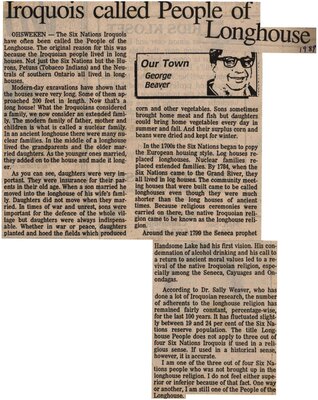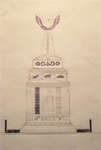"Iroquois Called People of Longhouse"
- Publication
- Brantford Expositor, 1989
- Full Text
- Iroquois called People of Longhouse
OHSWEKEN - The Six Nations Iroquois have often been called the People of the Longhouse. The original reason for this was because the Iroquoian people lived in long houses. Not just the Six Nations but the Hurons, Petuns (Tobacco Indians) and the Neutrals of southern Ontario all lived in longhouses.
Modern-day excavations have shown that the houses were very long. Some of them approached 200 feet in length. Now that's a long house! What the Iroquoians considered a family, we now consider an extended family. The modern family of father, mother and children is what is called a nuclear family. In ancient longhouse there were many nuclear families. In the middle of a longhouse lived the grandparents and the older married daughters. As the younger ones married, they added on to the house and made it longer.
As you can see, daughters were very important. They were insurance for their parents in their old age. When a son married he moved into the longhouse of his wife's family. Daughters did not move when they married. In times of war and unrest, sons were important for the defence of the whole village but daughters were always indispensable. Whether in war or peace, daughters planted and hoed the fields which produced corn and other vegetables. Sons sometimes brought home meat and fish but daughters could bring home vegetables every day in summer and fall. And their surplus corn and beans were dried and kept for winter.
In the 1700s the Six Nations began to copy the European housing style. Log houses replaced longhouses. Nuclear families replaced extended families. By 1784, when the Six Nations came to the Grand River, they all lived in log houses. The community meeting houses that were built came to be called longhouses even though they were much shorter than the long houses of ancient times. Because religious ceremonies were carried on there, the native Iroquoian religion came to be known as the longhouse religion.
Around the year 1799 the Seneca prophet Handsome Lake had his first vision. His condemnation of alcohol drinking and his call to a return to ancient moral values led to a revival of the native Iroquoian religion, especially among the Seneca, Cayuages and Onondagas.
According to Dr. Sally Weaver, who has done a lot of Iroquoian research, the number of adherents to the longhouse religion has remained fairly constant, percentage-wise, for the last 100 years. It has fluctuated slightly between 19 and 24 per cent of the Six Nations reserve population. The title Longhouse People does not apply to three out of four Six Nations Iroquois if used in a religious sense. If used in a historical sense, however, it is accurate.
I am one of the three out of four Six Nations people who was not brought up in the longhouse religion. I do not feel either superior or inferior because of that fact. One way or another, I am still one of the People of the Longhouse.
- Mystery Question
- When was this article published?[Please answer by clicking on the Comments tab]
- Creator
- Beaver, George, Author
- Media Type
- Newspaper
- Item Types
- Articles
- Clippings
- Description
- "The Six Nations Iroquois have often been called the People of the Longhouse. The original reason for this was because the Iroquoian people lived in long houses. Not just the Six Nations but the Hurons, Petuns (Tobacco Indians) and the Neutrals of southern Ontario all lived in longhouses."
- Date of Publication
- 1989
- Subject(s)
- Personal Name(s)
- Weaver, Sally.
- Local identifier
- SNPL002688v00d
- Collection
- Scrapbook #1 by Janet Heaslip
- Language of Item
- English
- Creative Commons licence
 [more details]
[more details]- Copyright Statement
- Public domain: Copyright has expired according to Canadian law. No restrictions on use.
- Copyright Holder
- Brantford Expositor
- Contact
- Six Nations Public LibraryEmail:info@snpl.ca
Website:
Agency street/mail address:1679 Chiefswood Rd
PO Box 149
Ohsweken, ON N0A 1M0
519-445-2954



